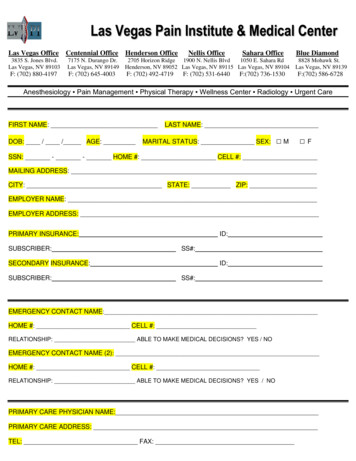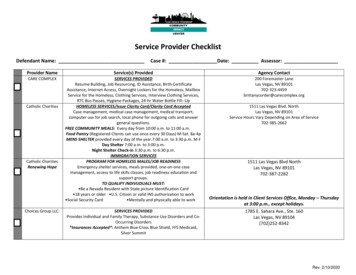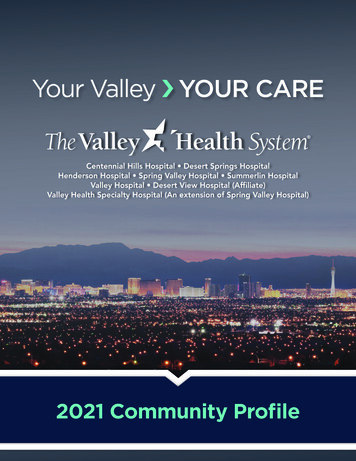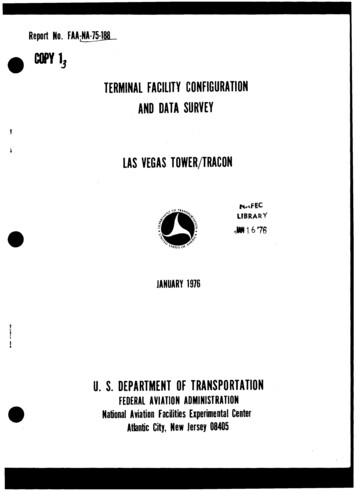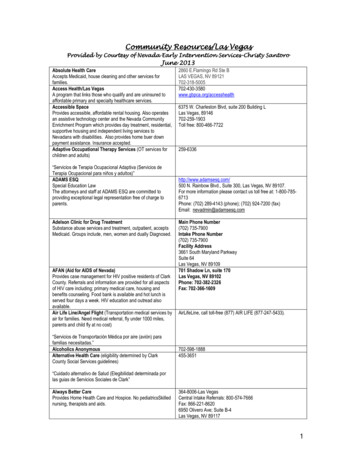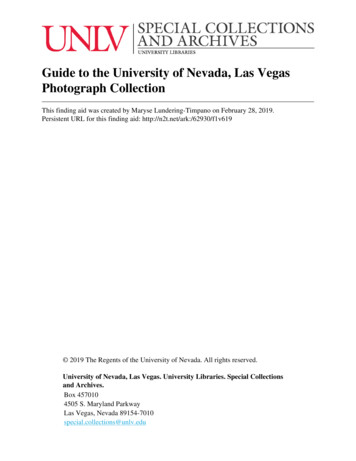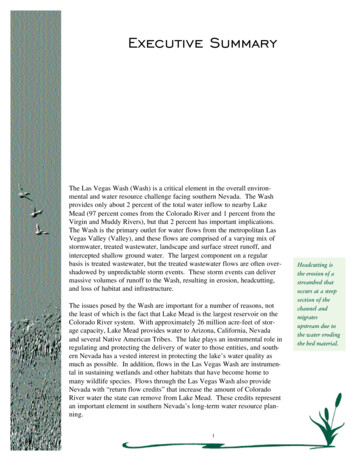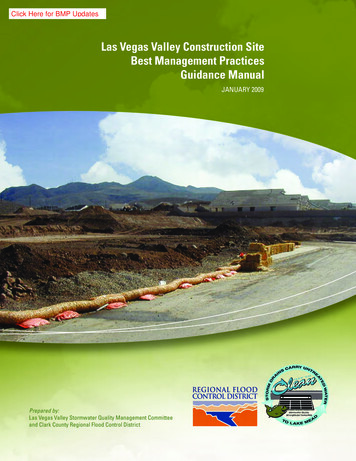
Transcription
Click Here for BMP UpdatesLas Vegas Valley Construction SiteBest Management PracticesGuidance ManualJANUARY 2009Prepared by:Las Vegas Valley Stormwater Quality Management Committeeand Clark County Regional Flood Control District
THIS PAGE LEFT BLANK INTENTIONALLY
Las Vegas Valley Construction SiteBest Management PracticesGuidance ManualJANUARY 2009Prepared by:Las Vegas Valley Stormwater Quality Management Committeeand Clark County Regional Flood Control District
THIS PAGE LEFT BLANK INTENTIONALLY
Guiding PrinciplesThe Las Vegas Valley Construction Site Best Management Practices Guidance Manual (BMP GuidanceManual) was developed by the Las Vegas Valley Stormwater Quality ManagementCommittee and Stormwater Stakeholders Working Group based on the following missionstatement and guiding principles.Mission StatementOur goal is to comply with the Municipal Separate Storm Sewer System (MS4) Permit bydeveloping construction and post-construction program enhancements that are: clear, simple and edfiscally and environmentally responsiblesensible for the Las Vegas ValleyGuiding Principles1. Owners/operators of construction sites are ultimately responsible for compliancewith all applicable rules and regulations related to construction activity.2. Owners/operators of construction sites should use their own experience andprofessional judgment in selecting specific best management practices for eachindividual application.3. Guidance on design and maintenance of best management practices provided in thisBMP Guidance Manual represents best practices in the industry, and establishesminimum standards of performance.4. Owners/operators of construction sites may propose use of best managementpractices not included in this BMP Guidance Manual, provided sufficientdocumentation is submitted to the local entity to demonstrate their effectiveness inthe Las Vegas Valley environment.5. The Las Vegas Valley Stormwater Quality Management Committee will regularlyupdate this BMP Guidance Manual to incorporate emerging practices and technologies.6. The Cities of Las Vegas (CLV), North Las Vegas (CNLV), Henderson (COH), andClark County (County) have all adopted a policy of working with contractors and siteowners/operators to achieve compliance with the program and an effective siterunoff management plan.Las Vegas Valley Construction Site BMP Guidance ManualJanuary 2009
THIS PAGE LEFT BLANK INTENTIONALLY
AcknowledgmentsThe Las Vegas Valley Construction Site Best Management Practices Guidance Manual (BMP GuidanceManual) was prepared by MWH Americas, Inc., under a contract with the Clark CountyRegional Flood Control District on behalf of the Las Vegas Valley Stormwater QualityManagement Committee. The Stormwater Quality Management Committee consists ofrepresentatives of each of the Co-Permittees under the municipal separate storm sewersystem NPDES permit for Las Vegas Valley. These Co-Permittees are Clark CountyRegional Flood Control District, Clark County, the Cities of Las Vegas, North Las Vegasand Henderson.This BMP Guidance Manual was developed to assist the Co-Permittees and members of thepublic involved in planning, designing and implementing construction activities with therequirements set forth in the Nevada Stormwater General Permit for Construction ActivityNVR100000 (the construction activity permit) and the ordinances of the Las Vegas Valleymunicipal entities. The Nevada Division of Environmental Protection (NDEP) issued andenforces the general construction permit. Staff members currently responsible fordeveloping and implementing the permit are Clifford Lawson and Steve McGoff of theNDEP Bureau of Water Pollution Control.Other City and County staff and stakeholders who were involved in the development of thisBMP Guidance Manual include the following:Kevin Eubanks, Clark County RegionalFlood Control DistrictDan Fischer, City of Las VegasJennifer Doody, City of North Las VegasAl Jankowiak, City of HendersonMark Silverstein, Department of AirQuality and EnvironmentalManagementPeggy Roefer, Southern Nevada WaterAuthorityEd Thurnbeck, Jacobs Carter BurgessMark Failla, Engineering and VendorsMark Jones, Southern Nevada HomeBuilders AssociationJoe Pantuso, Associated GeneralContractorsPam Scott, Homeowners AssociationsStuart Hitchen, Trade AssociationsTerry Murphy, Strategic SolutionsSpecial thanks to the Truckee Meadows Regional Stormwater Quality Management Programand Maricopa County for providing much of the information incorporated into this BMPGuidance Manual.The following staff members at MWH Americas, Inc., were responsible for preparing thisBMP Guidance Manual:Edwin “Chip” Paulson, Project ManagerJason JagerAngela MacKinnonAlicia DuranKazu MartinezLas Vegas Valley Construction Site BMP Guidance ManualJanuary 2009
THIS PAGE LEFT BLANK INTENTIONALLY
Table of ContentsSECTION 1.0 – INTRODUCTION1.11.21.31.41.51.61.71.8Historical Background .Purpose of Manual .Program Area .Overview of Manual Organization .Updates and Revisions to the BMP Guidance Manual .Disclaimer .Comments.Distribution .1-11-11-21-21-31-31-41-4SECTION 2.0 – STORMWATER QUALITY MANAGEMENT2.12.22.32.42.52.62.72.8Principles of Erosion and Sediment Control.Environmental Impacts of Runoff From Construction Sites.Best Management Practices .NPDES Permit Regulations .Nevada’s General Permit for Construction Activity .Projects Requiring Coverage Under NDEP’s General Permit .Permissible Non–Stormwater Discharges Under NDEP’s MS4 Permit .References .2-12-32-42-42-62-62-72-8SECTION 3.0 – THE LAS VEGAS VALLEY CONSTRUCTION SITERUNOFF MANAGEMENT PROGRAM3.13.23.33.43.5Local Conditions .Local Program Requirements .Legal Authority .Performance Standards.Local Policies and Procedures .3.5.1 Plan Review .3.5.2 Inspection and Enforcement .3.5.3 Public Reporting .3.5.4 Public Resources .3-13-13-23-33-43-53-73-73-7SECTION 4.0 – STORMWATER POLLUTION PREVENTION PLANS4.14.24.34.44.54.6Who Must Prepare a SWPPP .SWPPP Components .Pre-Construction Site Assessment .Runoff Coefficients and Discharge Rates .Detailed Site Map .Selecting Construction Site BMPs .Las Vegas Valley Construction Site BMP Guidance ManualJanuary 20094-14-14-24-24-34-4Page i
Table of Contents4.74.84.94.104.11Consistency With Other Construction Plans .Inspection and Monitoring .Potential Enforcement Actions .Records Retention .References and Websites .4-54-54-64-64-6SECTION 5.0 – PREFERRED BEST MANAGEMENT PRACTICES5.15.25.35.45.55.65.75.85.9Introduction .Selection Matrix .BMP Map Symbols .Step 1: Construction Planning Scheduling .Step 2: Erosion Control BMPs .5.5.1 Structural Controls .5.5.2 Vegetative Controls .5.5.3 Runoff Velocity Reduction .Step 3: Sediment and Pollutant Control BMPs .Step 4: General Housekeeping BMPs .Step 5: Review and Design the Proposed BMPs .Notice of Termination .APPENDIX A-NEVADA STORMWATER GENERAL PERMIT FORCONSTRUCTION ACTIVITY (NVR100000)APPENDIX B-LOCAL CONSTRUCTION PROGRAM CHECKLISTSAPPENDIX C-CONSTRUCTION SITE BEST MANAGEMENT PRACTICESPage ii5-15-15-35-65-75-85-85-85-95-95-105-10Las Vegas Valley Construction Site BMP Guidance ManualJanuary 2009
Table of ContentsList of TablesTableNumberTitle2-12-22-3Basic Soil Types and Erosion Potentials .Soil Surface Conditions at Construction Sites .Typical Construction Site Pollutants .2-22-32-53-1Existing Grading Regulations .3-25-1BMP Map Symbols .5-3Las Vegas Valley Construction Site BMP Guidance ManualJanuary 2009PagePage iii
Table of ContentsList of FiguresFigureNumber2-15-1Page ivTitlePageEffects of Erosion and Sediment Control Measures on SuspendedSediment Concentrations from Construction Sites(Schueler and Lugbill, 1990) .2-2Selection Matrix .5-2Las Vegas Valley Construction Site BMP Guidance ManualJanuary 2009
Table of ContentsList of AcronymsAPWAAmerican Public Works AssociationBATBest Available Technology Economically AchievableBCTBest Conventional Pollutant Control TechnologyBMPsBest Management PracticesBMP Guidance ManualConstruction Site Best Management Practices Guidance ManualBODBiological Oxygen DemandBWQPBureau of Water Quality PlanningCA RWQCBCalifornia Regional Water Quality Control BoardCaltransState of California Department of TransportationCCRFCDClark County Regional Flood Control DistrictCLVCity of Las VegasCNLVCity of North Las VegasCOHCity of HendersonCountyClark CountyCPESCCertified Professional in Erosion and Sediment ControlCPSWQCertified Professional in Stormwater QualityCWAClean Water ActDIDrop inlet (storm drain catch basin)ECerosion controlEPAUnited States Environmental Protection AgencyEOSEquivalent Opening SizeGHgood housekeepingHCDDMHydrologic Criteria and Drainage Design ManualIECAInternational Erosion Control AssociationLIDLow Impact DevelopmentLVVLas Vegas ValleyMEPMaximum Extent PracticableMS4Municipal Separate Storm Sewer SystemMSDSMaterial Safety Data SheetNDEPNevada Division of Environmental ProtectionNDFNevada Division of ForestryLas Vegas Valley Construction Site BMP Guidance ManualJanuary 2009Page v
Table of ContentsNDOTNevada Department of TransportationNOINotice of IntentNOTNotice of TerminationNOVNotice of ViolationNPDESNational Pollutant Discharge Elimination SystemNRCNational Response CenterNRCSNational Resource Conservation ServicePEProfessional EngineerPLplanningPLAProfessional Landscape ArchitectPLSProfessional Land SurveyorSNWASouthern Nevada Water AuthoritySPCsediment and pollutant controlSQMCStormwater Quality Management CommitteeSSWGStormwater Stakeholders Working GroupSWMPStorm Water Management PlanSWPPPStormwater Pollution Prevention PlanVOCVolatile Organic CompoundPage viLas Vegas Valley Construction Site BMP Guidance ManualJanuary 2009
Section 1Introduction
THIS PAGE LEFT BLANK INTENTIONALLY
Section 1.0 Introduction1.1Historical BackgroundThe United States Environmental Protection Agency (EPA) has adopted regulations to controlpollutants entering the environment through storm drainage facilities associated with Las VegasValley Municipal Separate Storm Sewer System (MS4). In compliance with these regulations, theNevada Division of Environmental Protection (NDEP) issued National Pollutant DischargeElimination System (NPDES) Permit No. NV0021911 jointly to Clark County Regional FloodControl District (CCRFCD); the City of Las Vegas (CLV), the City of North Las Vegas (CNLV), theCity of Henderson (COH), and Clark County (County). This permit, which was issued on June 19,2003, authorizes agencies to discharge from stormwater outfalls on Las Vegas Wash and itstributaries.The permit requires that the Co-Permittees develop a Storm Water Management Plan (SWMP). OnSeptember 29, 2003, the Co-Permittees submitted the SWMP to NDEP. The SWMP includesmanagement measures addressing source controls, runoff from developed areas, runoff fromindustrial sites, runoff from construction sites, and stormwater monitoring. The SWMP has beenupdated annually since 2003. In particular, an expanded construction site runoff managementprogram has been developed by the Co-Permittees. This program includes ordinances requiringerosion and control measures and prohibiting non-stormwater discharges to the drainage system;provides for inspection of construction sites by municipal personnel; defines enforcement measuresrelative to the ordinances; and provides training and guidance for selection of construction site BestManagement Practices (BMPs). This Las Vegas Valley Construction Site Best Management PracticesGuidance Manual (BMP Guidance Manual) is a part of that construction site runoff managementprogram.In September 2007, NDEP issued a Nevada Stormwater General Permit for Construction Activity(NVR100000). The permit presents specific requirements for the owners and operators of allapplicable private and public construction sites to control erosion, sediment and waste discharges tothe municipal storm drain system. The BMPs described in this BMP Guidance Manual are applicablefor meeting the management requirements of NDEP’s construction site permit.To develop the Construction Site Runoff Management Program and the BMP Guidance Manual, theStormwater Quality Management Committee (SQMC) formed the Stormwater StakeholdersWorking Group (SSWG). The SSWG is comprised of representatives from the municipalCo-Permittees, developers, homebuilding organizations, engineers, and the environmentalcommunity. The SSWG provided guidance on development of the specific components of theConstruction Site Runoff Management Program, including ordinances, construction approvalprocesses, inspection and enforcement protocols, and appropriate construction site BMPs. TheSSWG also participated in development of this BMP Guidance Manual.1.2Purpose of ManualThe primary purpose of the BMP Guidance Manual is to assist the local construction community withcompliance with NDEP’s general construction permit and the local policies developed in responseto the MS4 permit requirements. It is also intended to provide a comprehensive document thatincludes copies of all forms, checklists, stormwater quality management information, regulatoryLas Vegas Valley Construction Site BMP Guidance ManualJanuary 2009Page 1-1
Section 1.0 Introductioninformation and BMP standards and specifications necessary to comply with NDEP and localrequirements. The BMPs presented in the BMP Guidance Manual were carefully selected to provide awide variety of appropriate controls for use with the soils and climate of the Las Vegas Valley. Theintended users of the BMP Guidance Manual include the owners/operators of construction sites,developers, design engineers, contractors and staff from CCRFCD, Clark County and the Cities ofLas Vegas, North Las Vegas and Henderson.1.3Program AreaThe local Construction Site Runoff Management Program applies to construction activities in thearea known as the Las Vegas Valley, which consists of the Cities of Las Vegas, North Las Vegas andHenderson and the portion of unincorporated Clark County situated in the Las Vegas Washwatershed. The development boundary for the Las Vegas Valley is identified in the SouthernNevada Public Land Management Act. Per the municipal stormwater discharge permit issued jointlyto the five Co-Permittees, the receiving waters in the Las Vegas Valley include Las Vegas Wash andits tributaries.Information in this BMP Guidance Manual related to federal and state regulations and BMP designsmay be used by owners/operators of construction sites located outside of Las Vegas Valley, but inthe Clark County Regional Flood Control District service area. However, information on localordinances and other construction site management program requirements applies only to thecommunities in the Las Vegas Valley MS4 permit area.1.4Overview of Manual OrganizationThe BMP Guidance Manual is organized as follows:Page 1-2 Section 1 provides the history and purpose of the BMP Guidance Manual and itsorganization. Section 2 introduces the concept of stormwater quality management, theenvironmental impacts of runoff, the United States Environmental ProtectionAgency (EPA) stormwater program, and the Nevada Stormwater General Permit forConstruction Activity. Section 3 provides information on the local Construction Site Runoff ManagementProgram, the legal authority of NDEP and local agencies to conduct inspections andenforcement actions, local performance standards and policies and procedures. Section 4 provides information about who must prepare a Stormwater PollutionPrevention Plan (SWPPP), its basic components, recommended pre-construction siteassessment procedures, and guidance for completing the model SWPPP andselecting BMPs. Section 5 presents the list of preferred BMPs for use at construction sites in theLas Vegas Valley, and a series of BMP fact sheets for Planning, Erosion Control,Las Vegas Valley Construction Site BMP Guidance ManualJanuary 2009
Section 1.0 IntroductionSediment and Pollutant Control, and General Housekeeping. Detailed informationon the purpose, application, limitations, standards and specifications, inspection, andmaintenance requirements of each BMP is provided.1.5 Appendix A provides a copy of the Nevada Stormwater General Permit forConstruction Activity (NVR100000). Appendix B provides blank copies of the local procedural checklists that will beused when applying for any type of construction permit. Appendix C provides construction site BMP fact sheets.Updates and Revisions to the BMP Guidance ManualThe EPA requires owners and operators of construction sites to use the Best Available TechnologyEconomically Achievable/Best Conventional Pollutant Control Technology (BAT/BCT) to controlerosion, sediment and other pollutants identified by the Clean Water Act (CWA). This technology isevolving with new and innovative BMPs constantly being developed. In order to ensure that theBMPs utilized in the Las Vegas Valley meet the BAT/BCT standard, the Co-Permittees willperiodically review and approve new or innovative BMPs. New approved BMPs will be added tothe regional stormwater website www.lvstormwater.com. In addition, the Co-Permittees will reviewand update the BMP Guidance Manual every five years. This schedule will ensure that the review andupdate process occurs at least once during each five-year NDEP and MS4 stormwater permit cycle.The review process will consist of two tasks: (1) a technical review of the new BMPs used locallyand by other communities, and recommended by the EPA; and (2) a procedural review of how wellthe BMP Guidance Manual is being applied in the Las Vegas Valley. Design engineers andcontractors, as well as agency review and inspection staff, will be interviewed to determine potentialdeficiencies and to suggest improvements.1.6DisclaimerThe Las Vegas Valley BMP Guidance Manual should be used as a guidance document to minimizeerosion and polluted runoff from construction sites. The controls and performance standardsdescribed herein are intended to serve as minimum control standards or BMPs. They should beused to assist with consistent regulation of construction activities by applying a uniform standard.Not all of the control practices noted in this BMP Guidance Manual are necessary or even appropriatefor all construction sites. Proper training is recommended prior to preparing SWPPPs and installingand inspecting the BMPs described herein. The responsibility for complying with the requirementsof all stormwater regulations applying to construction sites lies with the site owner/operator.Las Vegas Valley Construction Site BMP Guidance ManualJanuary 2009Page 1-3
Section 1.0 Introduction1.7CommentsComments and questions on the BMP Guidance Manual and the Las Vegas Valley Stormwater QualityManagement Program may be directed to:General ManagerClark County Regional Flood Control District600 Grand Central ParkwaySuite 300Las Vegas, Nevada 89106Phone:(702) 685-0000Website: www.lvstormwater.com1.8DistributionDigital copies of the Las Vegas Valley Construction Site BMP Guidance Manual can be obtained fromeither the CCRFCD website (www.ccrfcd.org) or the Stormwater Quality Management Committeewebsite (www.lvstormwater.com). Reference hard copies are available at the permit counters foreach entity.Page 1-4Las Vegas Valley Construction Site BMP Guidance ManualJanuary 2009
Section 2Stormwater Quality Management
THIS PAGE LEFT BLANK INTENTIONALLY
Section 2 Stormwater Quality Management2.1Principles of Erosion and Sediment ControlErosion control practices focus on protecting soil surfaces and preventing the particles from beingdetached by wind or rain, whereas sediment control practices trap the soil particles after they havebeen dislodged and moved by wind or water (CA RWQCB, 1999). Erosion controls are generallyconsidered more efficient and cost effective than sediment controls because they keep soils in placeand do not require costly sediment removal and maintenance procedures. The combined use ofthese two BMPs is often required at construction sites to manage pollution in stormwaterdischarges.Maintaining natural drainage (preservation of vegetation, surface soils and grade) is the mosteffective means of filtering sediment and pollution and regulating the volume of runoff from landsurfaces adjacent to streams (CA RWQCB, 1999). When it is not possible to maintain a naturalstate, sediment runoff from disturbed surfaces can be reduced significantly through the use of soilstabilization practices, sediment barriers and controls, and the stabilization of vehicle access roads.Some of these practices are temporary and only remain in effect during construction. Others arepermanent and remain after construction is completed or until the site is stabilized or revegetated.Figure 2-1 provides a comparison of sediment concentrations in stormwater runoff dischargedfrom sites with various levels of controls in place. The data in this figure were developed fromwatersheds with considerably more vegetation and lower natural sediment production rates than inthe arid Las Vegas Valley, and thus benefits of construction site BMPs on sediment control are likelyoverstated for the Las Vegas Valley area. However, the same principles apply.Limiting the amount of disturbed soil area is also a critical component of an effective stormwatermanagement program. Some agencies place limitations on the amount of total disturbed soil areaeach project can expose until either temporary or permanent erosion control measures are in place.Limitations on the amount of continuous disturbed soil area is also important, particularly onexposed slopes. Slope length and inclination are considered the most important criteria for soilstabilization and sediment controls, because these two factors have the largest potential impact onerosion rates. Slope lengths can be limited by installing measures that effectively break up the slopelength, reduce runoff velocities and trap sediments. Terraces and linear sediment barriers such asfiber rolls can be implemented for this purpose.Different soil types and soil surface conditions also influence erosion potentials. Table 2-1 presentsthe erodibility classification of several different basic soil types. Soil erodibility is the propensity forsoil particles to become detached by the erosive actions of water and wind. It is also a function ofsoil texture, organic matter content, soil structure and permeability.Las Vegas Valley Construction Site BMP Guidance ManualJanuary 2009Page 2-1
Mean Sediment Concentration in Stormwater (mg/l)Section 2 Stormwater Quality Post ConstructionUndeveloped0No BMPsErosion BMPs OnlyErosion andSediment BMPsFigure 2-1Effects of Erosion and Sediment Control Measures onSuspended Sediment Concentrations From Construction Sites(Schueler and Lugbill, 1990)Table 2-1Basic Soil Types and Erosion PotentialsSoil TypeLow-PlasticitySilty SandClayey SandHigh-Plasticity SiltLow-Plasticity Organic SoilLow-Plasticity ClayHigh-Plasticity ClaySilty GravelWell-Graded SandPoorly Graded GravelWell-Graded GravelErodibility ClassificationMost ErodibleLeast ErodibleReference: Fifield, 2002Page 2-2Las Vegas Valley Construction Site BMP Guidance ManualJanuary 2009
Section 2 Stormwater Quality ManagementTable 2-2 presents a comparison of soil surface conditions at construction sites and the impact onincreasing or reducing erosion potentials. Land management practices or techniques that roughensoil surfaces and disrupt sheet flow effectively act to reduce the velocity of runoff waters, reduceerosion potentials, enhance infiltration and promote the establishment of vegetation. Shielding soilsurfaces with covers, such as mulches, enhances soil roughening effectiveness, protects disturbedsoils and helps to preserve soil moisture, further enhancing the revegetation success. BMPs that canbe effectively used to reduce erosion at construction sites are presented in Section 5 andAppendix C.Table 2-2Soil Surface Conditionsat Construction SitesSoil Surface ConditionCompacted and SmoothTrack walked along contoursTrack walked up and down slopeSparse crimped strawLoose to 12 inches in depth2.2Impact on Erosion(%) 30 20–10–10–20Environmental Impacts of Runoff From Construction SitesErosion and sediment transport are natural processes that form landscapes and provide the bedloadsrequired to maintain stable streams and rivers. Sediment and gravel transported from undevelopedland surfaces also provides important fish spawning medium and is critical to support other aquatic,riparian and terrestrial habitats. Disturbances within watersheds from man-made activities cangreatly accelerate the process of erosion and sediment transport, resulting in excessive deposition ofsediments in streams and rivers, and other negative environmental impacts.All of the current and future urbanized area in the Las Vegas Valley is located in watersheds thatdrain to the Las Vegas Wash and its tributaries. The Wash supports numerous plant and animalspecies. It drains to Lake Mead, which is the primary source of drinking water for Southern Nevada.Protection of Las Vegas Wash and its tributaries from potential negative impacts, such asdegradation from improperly managed construction activities, is of concern to local, state andfederal agencies as well as many o
The Las Vegas Valley Stormwater Quality Management Committee will regularly update this . BMP Guidance Manual. to incorporate emerging practices and technologies. 6. The Cities of Las Vegas (CLV), North Las Vegas (CNLV), Henderson (COH), and Clark County (County) have all adopted a policy of working with contractors and site
